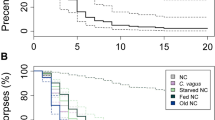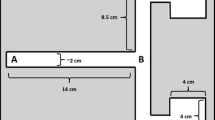Abstract
Caterpillars of Eriogaster lanestris (Lepidoptera: Lasiocampidae) mark trails as they move between feeding sites and their communal tent. They prefer new trails over aged ones. Hungry caterpillars prefer trails marked by fed caterpillars returning to the tent. Thus successful foragers direct tentmates to profitable food finds, in a manner similar to that of Malacosoma americanum. E. lanestris readily follows trails prepared from 5β-cholestane-3-one, a component of the trail marker of M. americanum, when applied at a rate of ≥10−10 g/cm. In choice tests, they preferred more highly concentrated over weaker trails. New trails are always established in groups, and the velocity increases from early to late caterpillars traversing a new trail.
Similar content being viewed by others
REFERENCES
Balfour-Browne, F. (1933). The life history of the “smaller eggar moth,” Eriogaster lanestris L. Proc. Zool. Soc. Lond. 161-180.
Capinera, J. L. (1980). A trail pheromone from silk produced by larvae of the range caterpillar Hemileuca oliviae (Lepidoptera: Saturniidae) and observations on aggregation behaviour. J. Chem. Ecol. 6: 655-664.
Costa, J. T., and Pierce N. E. (1997). Social evolution in the Lepidoptera: Ecological context and communication in larval societies. In Choe, J. C., and Crespi, B. J. (eds.), The Evolution of Social Behavior in Insects and Arachnids, Cambridge University Press, Cambridge, pp. 402-442.
Ebert, G. (ed.) (1994). Die Schmetterlinge Baden-Württembergs, Vol. 4. Nachtfalter II, Verlag Eugen Ulmer, Stuttgart.
Fitzgerald, T. D. (1993a). Trail and arena marking by caterpillars of Archips cerasivoranus (Lepidoptera: Tortricidae). J. Chem. Ecol. 19: 1479-1489.
Fitzgerald, T. D. (1993b). Trail following and recruitment: Response of eastern tent caterpillar Malacosoma americanum to 5?-cholestane-3, 24-dione and 5?-cholestane-3-one. J. Chem. Ecol. 19: 449-457.
Fitzgerald, T. D. (1995). The Tent Caterpillars, Cornell University Press, Ithaca, NY.
Fitzgerald, T. D., and Costa, J. T. (1986). Trail based communication and foraging behavior of young colonies of the forest tent caterpillar Malacosoma disstria Hübn. (Lepidoptera: Lasiocampidae). Ann. Entomol. Soc. Am. 79: 999-1007.
Fitzgerald, T. D., and Costa, J. T. (1999). Collective behavior in social caterpillars. In Detrain, C., Denoubourg, J. L., and Pasteels, J. M. (eds.), Information Processing in Social Insects, Birkhauser Verlag, Basel, pp. 379-400.
Fitzgerald, T. D., and Edgerly, J. S. (1982). Site of secretion of the trail marker of the eastern tent caterpillar. J. Chem. Ecol. 8: 31-39.
Fitzgerald, T. D., and Peterson, S. C. (1983). Elective recruitment communication by the eastern tent caterpillar (Malacosoma americanum ). Anim. Behav. 31: 417-442.
Fitzgerald, T. D., and Peterson, S. C. (1988). Cooperative foraging and communication in caterpillars. BioScience 38: 20-25.
Fitzgerald, T. D., and Underwood, D. L. A. (1998a). Communal foraging behavior and recruitment communication in Gloveria sp. J. Chem. Ecol. 24: 1381-1396.
Fitzgerald, T. D., and Underwood, D. L. A. (1998b). Trail marking by the larva of the Madrone butterfly Eucheira socialis and the role of trail pheromone in communal foraging behavior. J. Insect Behav. 11: 247-262.
Fitzgerald, T. D., and Webster, F. X. (1993). Identification and behavioral assays of trail pheromone of the forest tent caterpillar, Malacosoma disstria Hübner (Lepidoptera: Lasiocampidae). Can. J. Zool. 71: 1511-1515.
Hölldobler, B., and Wilson, E. O. (1990). The Ants, Belknap Press, Cambridge.
Joos, B., Casey, T. M., Fitzgerald, T. D., and Buttemer, W. A. (1988). Roles of the tent in behavioral thermoregulation of eastern tent caterpillars. Ecology 69: 2004-2011.
Knapp, R., and Casey, T. M. (1986). Thermal ecology, behavior, and growth of gypsy moth and eastern tent caterpillars. Ecology 67: 598-608.
Parry, D., Spence, J. R., and Volney, J. A. (1998). Budbreak phenology and natural enemies mediate survival of first-instar forest tent caterpillar (Lepidoptera: Lasiocampidae). Environ. Entomol. 27: 1368-1374.
Roessingh, P. (1989). The trail following behaviour of Yponomeuta cagnagellus. Entomol. Exp. Appl. 51: 49-57.
Roessingh, P. (1990). Chemical markers from the silk of Yponomeuta cagnagellus. J. Chem. Ecol. 16: 2203-2216.
Ruf, C., and Fiedler, K. (2000). Thermal gains through collective metabolic heat production in social caterpillars of Eriogaster lanestris. Naturwissenschaften 87: 193-196.
Sachs, L. (1992). Angewandte Statistik: Anwendung statistischer Methoden, 7th ed., Springer Verlag, Berlin.
StatSoft Inc. (1999). Statistica for Windows, version 5.5, StatSoft, Inc., Tulsa, OK.
Traniello, J. F. A., and Robson, S. K. (1995). Trail and territorial communication in social insects. In Cardé, R. T., and Bell, W. J. (eds.), Chemical Ecology of Insects 2, Chapman & Hall, New York, pp. 241-286.
Weyh, R., and Maschwitz, U. (1978). Trail substance in larvae of Eriogaster lanestris L. Naturwissenschaften 65: 64.
Author information
Authors and Affiliations
Corresponding author
Rights and permissions
About this article
Cite this article
Ruf, C., Costa, J.T. & Fiedler, K. Trail-Based Communication in Social Caterpillars of Eriogaster lanestris (Lepidoptera: Lasiocampidae). Journal of Insect Behavior 14, 231–245 (2001). https://doi.org/10.1023/A:1007841828892
Issue Date:
DOI: https://doi.org/10.1023/A:1007841828892




